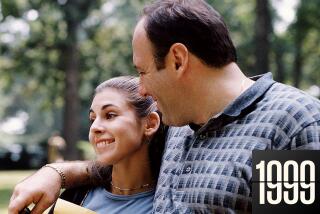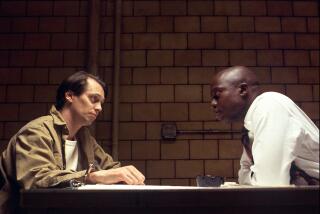10 years after ‘The Wire,’ cast members reflect on their careers after the classic series
When HBO’s heralded series “The Wire” went off the air 10 years ago, it wasn’t immediately clear that it would be a launching pad for much of the ensemble.
Sure, the show had been hailed as one of, if not the, greatest television drama ever and it launched series regulars Idris Elba (Russell “Stringer” Bell) and, less directly, Michael B. Jordan (Wallace) to stardom while making names for other cast members including Dominic West (Jimmy McNulty), Michael K. Williams (Omar Little), Wendell Pierce (William “Bunk” Moreland) and Clarke Peters (Lester Freamon).
But the intense five-season drama set in inner-city Baltimore did not provide the instant spark that some actors expected, says Lance Reddick, who played the impressive and intimidating police commander Cedric Daniels. It was only over time, as the show’s stature grew, some actors say, that it truly rewrote the arc of their careers.
After the series finale, Anwan Glover, who played the low-key gangster Slim Charles, says “the largest African American cast ever” was looking for jobs in a world “without enough roles for us.”
“I thought I’d made it, easy breezy, and my career was about to take flight,” adds Chad L. Coleman, who played reformed gangbanger Dennis “Cutty” Wise. “But with that many people of color in the cast not everyone was going to get off the runway.”
Additionally, creator David Simon’s masterpiece was more acclaimed than popular — its most successful season averaged well less than half the peak popularity of HBO shows such as “The Sopranos,” “Game of Thrones” or “True Blood.” In fact, the show’s popularity grew after the last episode in March 2008 as viewers belatedly discovered it on demand.
“It’s inverse to normal with the show’s popularity growing after it went off the air,” says Reddick. “It’s a weird phenomenon.”
Even as the audience and reputation continued growing, pitfalls remained. Some Hollywood writers and producers were misled by the show’s unnerving street level authenticity and casting of locals with more of a criminal history than an acting resume (such as Felicia “Snoop” Pearson or Melvin Williams, who played the Deacon and inspired the Avon Barksdale character, who was, in turn, portrayed by Wood Harris.
“It was so authentic, people thought we weren’t actors,” says Gbenga Akinnagbe, who played efficient killer Chris Partlow. “At industry events, people would ask, ‘What are you doing here?’ And I’d say, ‘What do you mean?’ and they’d say, ‘What are you doing out of Baltimore?’ ”
Jamie Hector, who played the ruthless drug lord Marlo Stansfield, felt like he needed to mention in meetings that he’s a Lee Strasberg Theater and Film Institute alumni so people would know he was a legitimate actor. Hector was often typecast afterward as a bad guy; he says that happened before “The Wire” too — that’s what is too often offered to African American actors.
But he’s philosophical about it: “I’d rather be pigeonholed than no holed,” he says. “At least I was working.”
Before “The Wire,” Reddick had played a crackhead on Simon’s “The Corner” and a heroin addict on “Oz” but also a cop and a medical examiner in other recurring roles. He initially auditioned for homicide detective Bunk Moreland and then for the junkie Bubbles, before getting cast as Daniels.
Playing Bubbles would have meant “a very different career path,” since “The Wire” led directly to five years on the Fox series “Fringe”, in a law enforcement authority role. (After that, he consciously sought variety, donning a wig and makeup for an “American Horror Story” voodoo role and playing for laughs in a Key and Peele sketch and on “Corporate” while seeking more film roles.)
Maestro Harrell, who played Randy Wagstaff, one of the lost boys of Season 4, reshaped his career by hacking off his braid. The new look led to recurring roles as a preppy intellectual in “Suburgatory” and as a businessman in Showtime’s “House of Lies.” “I want my reel to look diverse,” Harrell says.
When Glover read for Dunn Purnsly on HBO’s “Boardwalk Empire” he was rejected with the line, `We loved you as Slim.’ So he too cut his braids, which led to a wider array of roles.
Doing shows after “The Wire” was like a theater actor doing a play after “Hamlet.”
“I’d find myself on the set of a show feeling down, and I didn’t know why,” says Akinnagbe. “It took a while till I realized I have to accept that not all work is the same, and I have to find something interesting in each character. With ’The Wire’ we were thrilled every week — we’d read the script immediately and call each other to say, ‘Did you see that?’ ”
Seth Gilliam, who played detective Ellis Carver, was braced for that. “I watch TV so I didn’t have highfalutin ideas about the quality of other shows,” he says. “But I wasn’t in a position to say ‘No’ because this show sucks or to say, ‘Change this about my character.’ ”
While actors need to work, Hector says, “The Wire” did prompt him to “stand outside the game a little further and ask, ‘Is this character one-dimensional?’” and push for more nuanced roles.
Glover says that even when “Wire” alumni were going up for the same roles, they remained family. “We were not competing and there was not resentment. Everyone gives high fives when someone gets a role — we all are working somewhere.”
And ultimately, the show rewarded its cast.. After years in low-budget indie films, Tray Chaney (low level drug dealer Malik “Poot” Carr on “The Wire”) was recruited for Bounce TV’s “Saints and Sinners” (which costars J.D. Williams, Preston “Bodie” Broadus on “The Wire”). “They were big fans of the show and said, ‘We’ve got this part for you,’ ” he says.
“The creators of both `Teen Wolf’ and `The Walking Dead’ were fans of `The Wire’, says Gilliam of his two most recent series.
The most important connections for the cast were, of course, Simon and “Wire” writer-producers such as Eric Overmyer, who created “Treme” for HBO with Simon, and George Pelecanos, who worked with Simon on “Treme” and co-created HBO’s “The Deuce”. Overmyer gave Hector a chance to move beyond the villain roles with a leading role as a detective on the Amazon series “Bosch.” Equally important, Hector says, was the “mark of excellence” that Overmyer’s “Wire” pedigree provided.
Simon’s series have been a bounty:” “Treme” starred Pierce and Peters, with roles for Glover, Jim True-Frost, James Ransone and Steve Earle, while “The Deuce” has featured Akinnagbe, Lawrence Gilliard Jr., Glover and other “Wire” regulars Method Man, Chris Bauer, and Michael Kostroff.
Pelacanos tries to make sure that “Wire” cast members aren’t limited by their roles in that landmark series. “People will say, ‘He played a drug dealer so nobody will believe him as a lawyer or policeman,’” which is why Gilliard, who played D’Angelo Barksdale on “The Wire” plays an upstanding cop on “The Deuce.”
“They audition but they definitely have a leg up,” says Pelacanos, who just cast Akinnagbe, Glover, Jermaine Crawford (Duquan “Dukie” Weems), Nathan Corbett (Donut) and Brandon Price (Anton “Stinkum” Artis) in “DC Noir”, a film he wrote and produced. “They are like family. That connection is there.”
More important than that connection, Akinnagbe and Hector say, is the way “The Wire” changed perceptions. “It forced people to see that we really can act and should be allowed to play different roles and to tell nuanced stories,” Hector says.
“It took a while,” Akinnagbe adds, “but the show definitely influenced a whole generation of TV and film writers who now write deeper and more complex characters.”
More to Read
Only good movies
Get the Indie Focus newsletter, Mark Olsen's weekly guide to the world of cinema.
You may occasionally receive promotional content from the Los Angeles Times.





